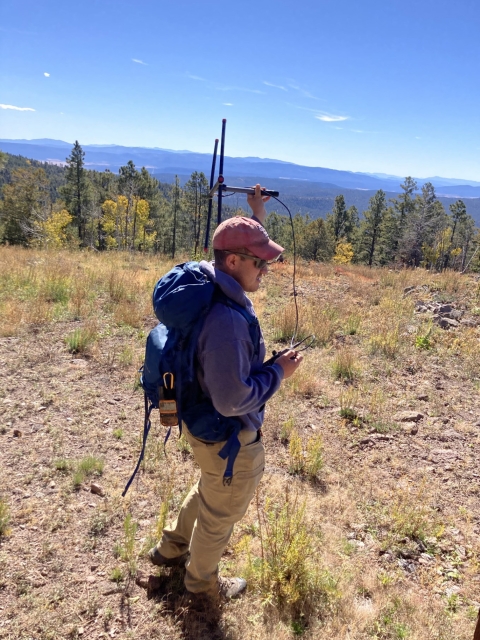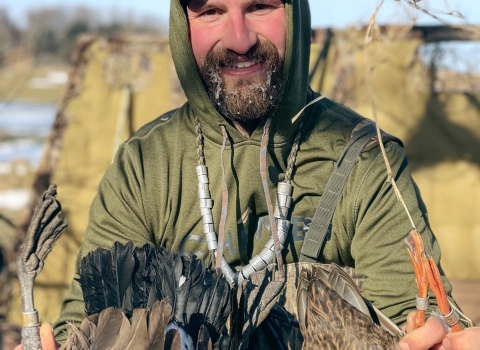When a female Mexican wolf is ready to give birth to pups, she will choose a location and prepare aden for the new arrivals. For people, finding one of these wolf dens in the wild is no easy task (the chances of stumbling upon one are extremely slim).
Yet for staff working on Mexican wolf recovery, finding wolf dens is an essential skill and part of their job. Radio collars make finding dens possible, but unlike smartphones with GPS, they do not take biologists straight to the front door (or in this case, den door).
Radio collars submit GPS points, which the Service and partners have access to. A breeding female will transmit points until she enters her den, at which point the signal cannot transmit. That is the only way biologists know a wild female Mexican wolf has given birth—she disappears off the map.
“Back in the day, before GPS radio collars, we had to locate the den using radio telemetry only,” says Allison Greenleaf, wolf biologist with the Service. “Unlike GPS, the radio signal on a collar never disappears completely, but it does get quiet. The only way to find the den was to triangulate the radio signal daily. This meant going out to the same three spots every day, taking a bearing of where the signal is the strongest, hiking or driving to next spot, taking another bearing, and then triangulating triangle all three where they intersect.”
Whether using GPS points or telemetry triangulation, finding a den still takes an experienced eye (GPS locations can be up to 100 meters off). One sign that you are close is if there are well run paths in the dirt or grass, which the wolves have worn down making regular trips to the den. Another sign is fresh scat (wolf poop) as well as wolf beds and bones from prey.
“Once you see all of these signs in a tight area, you know you are close and ready to start your search,” says Greenleaf. “I always look for fresh dirt that has been dug out. The female cleans out her den every day, so finding fresh dirt tells me I’ve likely found the den opening.”
Into the Wild
The primary reason biologists need to find Mexican wolf dens in the wild is to carry out pup fostering efforts. Fostering is a proven method used by the Mexican Wolf Interagency Field Team to increase genetic diversity in the wild Mexican wolf population. It begins with carefully managed breeding by the Mexican Wolf Species Survival Plan (SSP) program to produce genetically diverse pups within the captive population. Within 14 days of whelping, the captive-born pups are transported to the wild and mixed together with similarly aged wild pups.
It sounds easy, but fostering is a complex process that takes careful planning and coordination, as well as a lot of luck. And because wolves are extremely skittish and spook easily, the search for the wild den cannot begin until the captive-born pups have left their facility and are en route to the forests of Arizona or New Mexico.
“If we try to find the den too early, the female will sense us and move the pups to a new den," says Greenleaf. "Finding the new den would be just a shot in the dark, which is why we usually do not go out in search for the wild den until about an hour before the captive pups arrive.”
Only the Brave (and Small)
As soon as people near the den, the female will leave her den with the pups inside. She and the other members of the pack will howl and make themselves visible. It can be nerve wracking for staff.
“It’s extremely stressful because the wolves are upset and you know you are the one responsible for stressing them out," says Greenleaf. "But I just focus on the task at hand which is finding the den as quickly as possible. Once that happens, my stress level drops, and I try to just get in and get our job done and get out as quickly as we can.”
Once the den is located, someone has to crawl in and retrieve the wild pups. Again, this job takes a certain mentality, and body frame.
“You have to crawl into an extremely narrow space, often with your arms in front of you, breathing in dust,” she adds. “It can be claustrophobic, so you have to have a have strong mind. You are also dealing with fragile pups, and you don’t want to hurt them. So, you go slow and be gentle.”
The Smellier the Better
Once the wild pups are pulled from the den, they are counted and given a health check and assigned a studbook number (Mexican wolves are given unique numbers instead of names as identifiers). Soon, the captive wolves arrive, and all the pups are placed in a puppy pile. To help ensure the captive pups are accepted alongside their wild born mates, staff will have the pups urinate (pee) and defecate (poop) on each other. Sounds gross, but this process helps ensure the female accepts all the pups.
Maternal Instincts
Once all the pups are equally smelly, they are placed back into the wild den. As soon as it is considered safe (no more people in the area), the female will return to her den. Knowing the den was disturbed, she will immediately dig a new den and move all the pups (captive born and wild born) to the new location.
Once mom and pups are safe in the new den, her maternal instincts kick in. She will feed and care for both the wild and captive-born pups. With the help of her pack mates, the pups will be raised with the skills and knowledge needed for a life in the wild.







